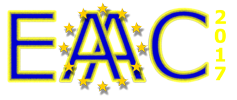Speaker
Dr
Joshua Moody
(Max Planck Institute for Physics)
Description
The AWAKE project has a uniform rubidium vapor source with baseline density of 7e14 cm^-3 that must be completely ionized radially to 1 mm over its entire 10 meter length. Furthermore, the ionization must be substantially faster than a single plasma period to seed the self-modulation instability. We use a 4.5 TW fiber / titanium:sapphire chirped pulse amplification laser system to ionize. Because two of the transitions to ionization lie within the full width at half maximum of the laser spectrum, significant anomalous dispersion occurs within the laser pulse if there are large valence electron populations in the ground (5S) or first excited state (5P). This dispersion along with diffraction can cause the laser to stretch longitudinally and expand transversely, decreasing the ionization probability. If the laser pulse energy is too low as it propagates through the extended vapor source, depletion until critical intensity occurs and the beam crashes, causing rapid expansion and stretching.
We show that the pulse crashing problem can be overcome by using laser pulses with sufficient energy and intensity to propagate the full length of the vapor source. The strengths and limitations of using a resonance enhanced scheme are also discussed.
Primary author
Dr
Joshua Moody
(Max Planck Institute for Physics)
Co-authors
Ms
Anna-Maria Bachmann
(CERN)
Dr
Erdem Oz
(Max Planck for Physics)
Mr
Fabian Batsch
(CERN)
Mr
Falk Braunmueller
(Max-Planck Institute for Physics)
Gabor Demeter
(Wigner Research Center for Physics)
Mr
Mathias Hüther
(Max-Planck-Institut für Physik)
Dr
Mikhail Martyanov
(Max Planck Institut fur Physik, Munich)
Prof.
Patric Muggli
(Max-Planck-Institut für Physik)

